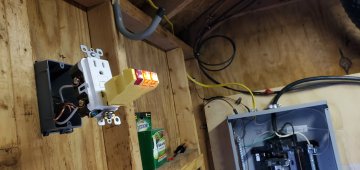Hedges
I See Electromagnetic Fields!
- Joined
- Mar 28, 2020
- Messages
- 20,535
GFCI outlet? or GFCI breaker? Only one should be needed.
Is that "Plug On Neutral"? I see what may be a neutral busbar for breaker to plug on to, and I don't see the pigtail of a traditional breaker.
With DMM, check voltages (Line, Neutral), (Line, Ground), (Ground, Neutral).
Doing the same with a light bulb across each pair of wires would provide a load (caution, if "ground" is not grounded, this can electrify ground through the light bulb so keep hands away!)
It may be that neutral is not yet grounded. But I thought the wires and green screw shown took care of that.
Is that "Plug On Neutral"? I see what may be a neutral busbar for breaker to plug on to, and I don't see the pigtail of a traditional breaker.
With DMM, check voltages (Line, Neutral), (Line, Ground), (Ground, Neutral).
Doing the same with a light bulb across each pair of wires would provide a load (caution, if "ground" is not grounded, this can electrify ground through the light bulb so keep hands away!)
It may be that neutral is not yet grounded. But I thought the wires and green screw shown took care of that.



